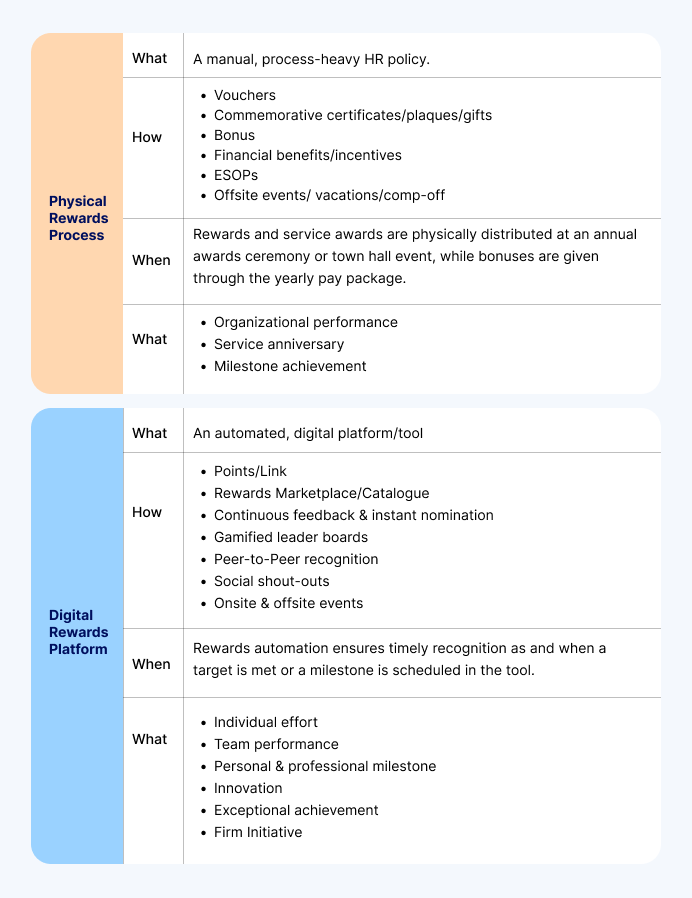Leaving the Past Behind: The Move from Traditional to Modern Digital Rewards Platform
Traditional rewards systems are falling short in today’s dynamic work culture. Explore how a digital rewards platform offers timely, personalized, and scalable recognition that empowers modern employee engagement and drives business results.
Auf dieser Seite
The way companies reward and recognize employees has shifted significantly. What used to be an occasional gesture tied to tenure or annual performance reviews is no longer enough for today’s diverse and distributed workforce.
A traditional reward system often relied on rigid structures, delayed feedback, and limited personalization. Bonuses once a year, service awards after five or ten years, and generic thank-you notes were seen as sufficient. But over time, these practices started to feel disconnected from the day-to-day experiences of employees.
People want to be appreciated in real time. They value recognition that is timely, personal, and tied to the actual impact they create. They also want rewards that reflect their interests and needs, not one-size-fits-all tokens.
This shift has paved the way for modern employee reward systems that prioritize flexibility, frequency, and relevance. With the help of technology, organizations now have the tools to recognize contributions continuously, deliver customized rewards, and make appreciation an everyday part of the employee experience.
Modern systems don't just replace the old ones—they redefine how companies think about engagement and motivation, offering a smarter and more meaningful approach to recognition.
Traditional rewards system
A traditional reward system is built on legacy practices that were once effective in more hierarchical, in-office workplaces. These systems often focused on tenure and top-down evaluations, offering rewards only after long periods of time and primarily in monetary form. They tend to be manual, rigid, and limited in their scope.
- Manual HR policy
Recognition programs are managed through spreadsheets, emails, or basic HR tools, leading to inefficiencies, inconsistencies, and a lack of visibility. - Performance bonus based on annual appraisal
Rewards are typically tied to an annual review process that doesn't reflect real-time performance or acknowledge day-to-day contributions. - Generic service or achievement awards
A “one-size-fits-all” approach with standard gifts or certificates that don’t reflect the individual’s preferences or the uniqueness of their effort. - End-result oriented, limited in scope
The focus remains on final outcomes, ignoring smaller wins or consistent efforts throughout the year. - Financial incentives only (ESOPs)
Rewards are mostly monetary, with little variety. Employees who value experiences, personal development, or social recognition often feel overlooked. - Delayed, reactive appreciation
Recognition is sporadic and often comes too late to make a meaningful impact on morale or motivation. - Localized application
Programs are not designed to scale across regions or accommodate a global workforce, limiting their relevance in multinational teams. - Top-down management approach
Only managers or leadership can initiate recognition, excluding peers from the process and reducing overall participation and engagement.
Modern rewards system
Modern employee reward systems reflect the values and expectations of today’s workforce. These systems are built on digital platforms, driven by data, and designed to be inclusive, immediate, and personalized. They create a culture where recognition is continuous and accessible to everyone.
- Automated digital platform
Technology takes care of workflows, approvals, and data tracking, reducing administrative effort and enabling scale across teams and geographies. - Real-time R&R based on continuous feedback
Recognition happens in the moment, based on real-time achievements and feedback, keeping it relevant and motivating. - Personalized experiences
Rewards can be tailored to each employee’s interests, preferences, or values, making the gesture more meaningful and appreciated. - Scope for innovation and progress
These systems reward creativity, collaboration, and new ideas—not just meeting targets—encouraging employees to think beyond KPIs. - Aimed at career development
Programs are designed to support long-term growth, tying recognition to learning goals, mentorship, and personal milestones. - Timely, proactive recognition
Smart nudges and automated reminders ensure achievements aren’t missed, helping managers and peers acknowledge contributions right away. - Global platform
These systems support multiple languages, currencies, and cultural contexts, making them effective for remote and international teams. - Employee-centric leadership
Recognition is democratized and built into everyday workflows. Peer-to-peer appreciation is encouraged, and leaders are guided by data to recognize equitably.
Why did traditional rewards system give way to a modern, digital rewards and recognition?
Mitarbeiter in aller Welt laufen seit Jahren Sturm gegen die traditionelle F&R, aber die meisten Unternehmen verschließen die Augen davor und entscheiden sich für "gut gemeinte Schnelllösungen, die nicht greifen". | McKinsey
In einem Artikel in der Harvard Business Review hob David Novak das Beispiel eines Onkologen in einem renommierten Krankenhaus hervor, der einen Schlüsselanhänger aus Kunststoff für seine 40-jährige Tätigkeit in demselben medizinischen Zentrum erhielt!
Diese eklatante Unflexibilität der traditionellen F&R, die zu einer hohen Fluktuation von Talenten führt, zwang Unternehmen weltweit dazu, ihre Belohnungs- und Anerkennungsprogramme neu zu kalibrieren. Es war endlich an der Zeit, dass die traditionellen Belohnungen den Bach runtergehen!
Outdated elements of traditional r&r
- Verspätete Anerkennung - Eine jährliche Preisverleihung mit verspäteter Anerkennung (wenn überhaupt) ist sowohl entmenschlichend als auch demotivierend.
- Keine Personalisierung - Allgemeine Wertschätzung und Geschenke berücksichtigen nicht die individuellen Bemühungen oder Beiträge.
- Mangelnde Kreativität - Die Wiederholung von Standard-Dankeschön-E-Mails und symbolischer Wertschätzung führt zu geringem Engagement.
- Keine ganzheitliche Erfahrung - Starke Abhängigkeit von Leistungsprämien und Serviceprämien anstelle von guten Erfahrungen.
- Manuell und prozesslastig - Ein langwieriger Beurteilungsprozess, der an ein unflexibles Bewertungssystem und mehrere Genehmigungsstufen gebunden ist.
- Ergebnisorientierter Fokus - Eine enge Sichtweise, die sich nur auf das Endergebnis konzentriert und nicht auf Fortschritt und Karriereentwicklung.
- Keine Anerkennung für Innovationen - Starke Betonung von Prozessen und Endzielen statt langfristiger Visionen und Innovationen.
- Lokalisierte Richtlinien - Lokalisierte F&R-Programme sind spezifisch für das Unternehmen, mit Richtlinien, die nicht auf globaler Ebene repliziert werden können.
Modern elements of digital r&r
- Rechtzeitige Anerkennung - Belohnungen und Anerkennungen in Echtzeit auf verschiedenen Geräten, um Mitarbeiter zu motivieren und zu fördern.
- Maßgeschneiderte Belohnungen - Der Einsatz von KI zur Personalisierung von Belohnungen auf der Grundlage von Mitarbeiterpräferenzen und individuellen Leistungen.
- Kreativ - Eine größere Vielfalt an Belohnungen mit Omnichannel-Einlösung führt zu höherer Zufriedenheit und Engagement
- Umfassend - Eine Kombination aus Echtzeit-Performance-Analysen, kontinuierlichem Feedback und maßgeschneiderter Anerkennung bietet ganzheitliche Erfahrungen
- Automatisiert - Eine automatisierte digitale Plattform mit analytikbasierter Messung von Leistungskennzahlen und integrierten Genehmigungen
- Entwicklungsorientiert - Klare Zielvorgaben durch die Plattform konzentrieren sich auf die berufliche Entwicklung der einzelnen Talente.
- Fokus auf Innovation - Die in der R&R-Plattform festgelegten KPIs stehen im Einklang mit der langfristigen Vision und den Innovationszielen des Unternehmens. - Globale Plattform - Eine Cloud-basierte Plattform mit Unterstützung für mehrere Sprachen und Währungen, die für jedes Unternehmen skaliert werden kann.
Empuls: Your Partner in Modern Employee Reward Systems
One of the most powerful digital rewards platforms on the market today, Empuls helps organizations transition from outdated R&R programs to modern employee reward systems seamlessly.
Empuls combines AI-powered recognition, peer-to-peer appreciation, and an expansive global rewards catalog to offer a truly digital rewards experience. With built-in automation, intelligent manager nudges, budget control, and rich people analytics, it allows HR teams to create a culture of real-time appreciation and inclusion.
Key Empuls capabilities include:
- Structured reward automation for milestones, spot awards, and nominations
- 1M+ global rewards catalog across 100+ countries
- White-labeled branding to personalize the experience
- eNPS and pulse surveys to keep engagement measured and meaningful
- Integrated communications via a social intranet with communities, celebrations, and wishboards
- Perks & discounts that improve overall financial wellness
- Global compliance (GDPR, SOC2, ISO27001) with multi-currency & multi-lingual support
Empuls empowers organizations to scale recognition globally while maintaining local relevance, which makes it an ideal replacement for the traditional reward system.
Transforming R&R with a global digital rewards platform
Moderne F&R ist auf die Nuancen der neuen Arbeitskräfte abgestimmt, und es gibt zwei Möglichkeiten, diese Entwicklung anzugehen.
1. Physical rewards process in the traditional system vs. digital rewards platform
Conventional rewards are limited in scope and lack the convenience and versatility of a digital rewards platform.
The top-down approach in the traditional rewards process places more importance on perceived abilities, whereas a platform like Empuls measures performance metrics using real-time data, leaving no room for bias and error.

2. Lokales vs. globales Belohnungsprogramm
Lokale F&R-Programme haben nur eine begrenzte Reichweite als eine globale Plattform mit größerer Reichweite.
Während kleine Unternehmen aufgrund des manuellen Charakters ihrer Abläufe und der geringeren Mitarbeiterzahl immer noch auf lokale Prämienprogramme setzen, verlassen sich große Unternehmen mit einer über mehrere Standorte verteilten Belegschaft und hybriden Abläufen (Büro- und Fernarbeit) auf skalierbare globale Plattformen mit automatisierten Prämien.
Die Verfügbarkeit zahlreicher SaaS-Plattformen auf dem Markt hat es Unternehmen jeder Größe ermöglicht, ihre Prämienprogramme zu digitalisieren, um ihre generationsübergreifende Belegschaft anzusprechen.
Lokales Belohnungsprogramm
- Mehrere isolierte HRMS- und HRIS-Tools mit unterschiedlichen Datenbanken, die nicht integriert werden können.
- Auf dem Papier als Personalpolitik dokumentiert, lokal in Sprache und Kultur.
- Gutscheine und Geschenkschecks in der Regionalwährung können nirgendwo anders eingelöst werden.
- Manuelle Prozesse sind anfällig für menschliche Voreingenommenheit und Fehler
Globales Prämienprogramm
- Eine einzige Plattform, die mit HRMS, Kollaborations- und SSO-Tools integriert werden kann.
- Kann mit mehrsprachiger/regionaler Unterstützung an jede Sprache und Kultur angepasst werden.
- Ein globaler Katalog mit Unterstützung mehrerer Währungen erweitert die Möglichkeiten der Einlösung.
- Belohnungsautomatisierung mit definierten Zielen und KPIs.
3. Beispiele in Echtzeit
- Physical rewards: E.On still swears by physical, but with heartfelt "thank you" notes incorporated into their Buzz recognition program.
- Digital rewards: Unilever's global digital reward system, uFlexReward, analyzes individual preferences to offer tailored benefits to fit employees' needs.
- Lokale Belohnungsprogramme: Alle US-amerikanischen Mitarbeiter von HP Inc., die mindestens 10 Stunden pro Quartal ehrenamtliche Arbeit leisten, erhalten eine Good Card im Wert von 50 US-Dollar.
- Globale Belohnungsplattform: Apple passt seine bezahlte Freistellung an den Standort und die Funktion eines Mitarbeiters an und berücksichtigt regionale, kulturelle und persönliche Vorlieben.
Unterm Strich!
Needless to say, a digital rewards program with its modern approach to R&R wins hands-down. By recognizing the immense value employees bring to their work and highlighting the best of this talent, a global rewards platform like Empuls improves the company's bottom line.
The old practices cannot match the simplicity, cost, and time-effectiveness of modern employee reward systems, and more importantly, they fall short of the expectations of a dynamic workforce looking for personalized, real-time R&R experiences!













